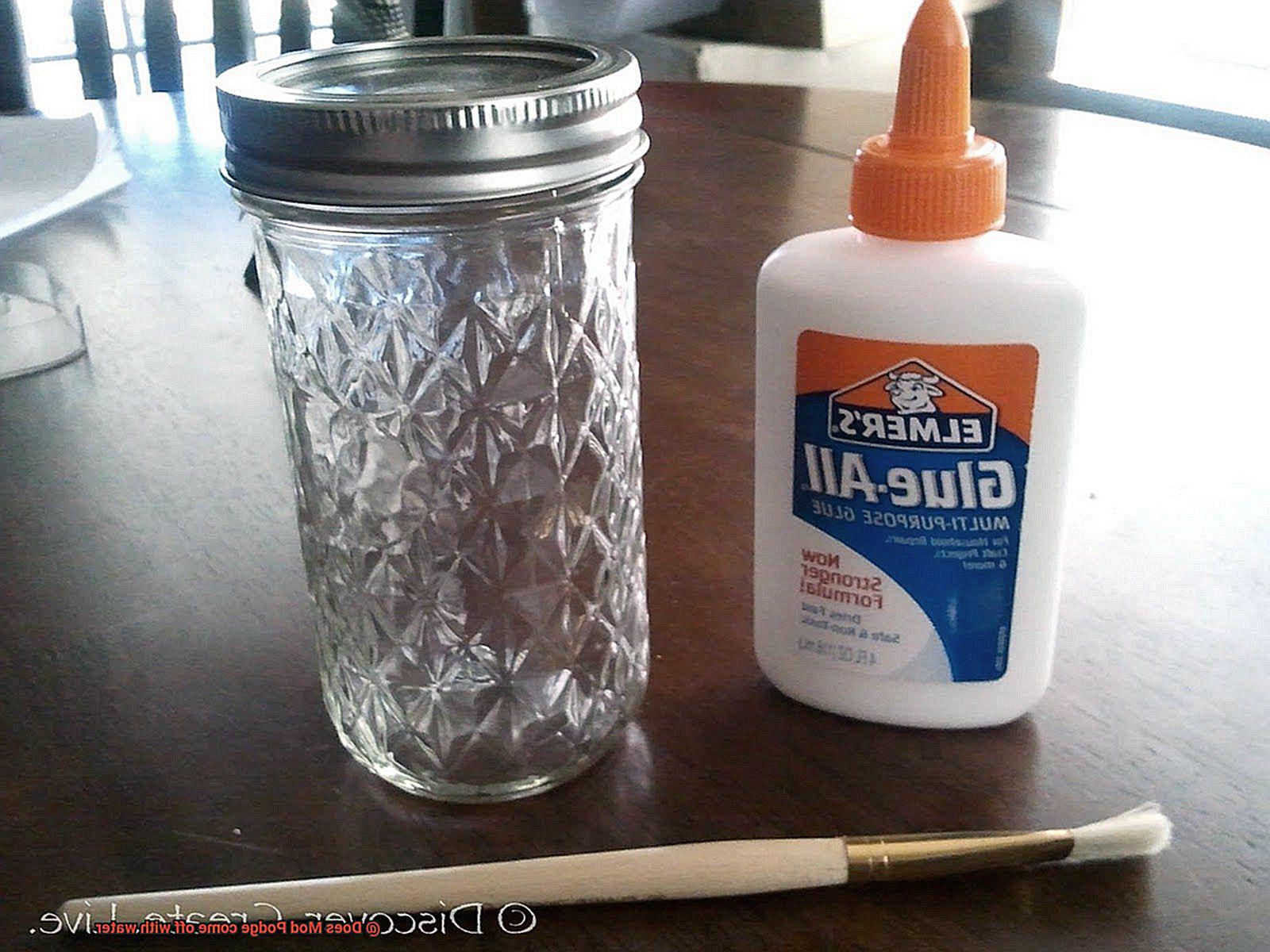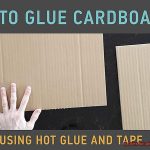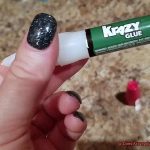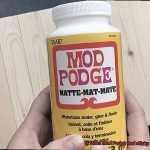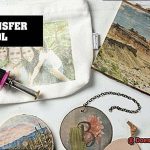It’s that magical place where we transform ordinary objects into extraordinary works of art. And in this realm of creativity, there is one adhesive that reigns supreme: Mod Podge. But let me ask you this – have you ever found yourself staring at your masterpiece, heart pounding, as a rogue droplet of water threatens to ruin it all? That’s when the burning question arises: Does Mod Podge come off with water?
Now, picture this: You’ve poured your heart and soul into a project. Hours of meticulous work, countless layers of Mod Podge lovingly applied. And then… disaster strikes. A splash of water lands on your creation, like a villainous plot twist in your crafting saga. Panic sets in. Is it game over? Will all your hard work dissolve before your eyes? Fear not, my crafty comrades. In this blog post, we’re diving deep into the mysterious relationship between water and Mod Podge.
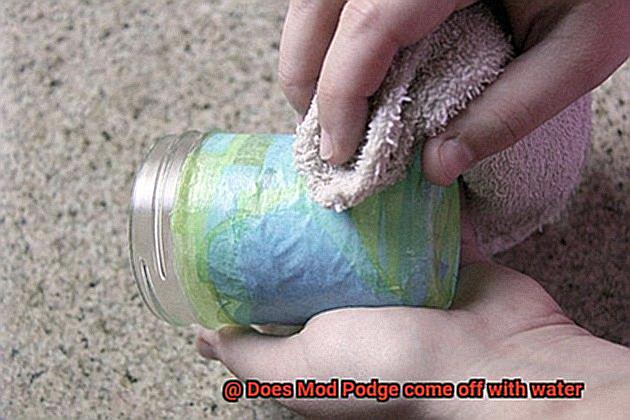
Get ready for an adventure filled with expert advice, practical tips, and maybe even a few cautionary tales from those who’ve experienced the highs and lows of Mod Podge mishaps. We’ll navigate through the murky waters (pun intended) to uncover the truth about whether our beloved adhesive can withstand the watery onslaught.
So grab yourself a cuppa joe or your beverage of choice, settle into your favorite crafting nook, and join me on this quest to unravel the enigma that is Mod Podge versus water. It’s time to separate fact from fiction and find out if our trusty adhesive can truly stand up to its aquatic nemesis.
What is Mod Podge?
Contents
- 1 What is Mod Podge?
- 2 How Does Mod Podge Work?
- 3 Does Mod Podge Come Off with Water?
- 4 What to Do if Accidentally Spilled on a Mod Podge-Sealed Surface?
- 5 Is it Recommended to Use Mod Podge in Wet Environments?
- 6 What is the Best Way to Remove Mod Podge from a Surface?
- 7 What Are the Potential Issues of Not Removing Mod Podge Properly?
- 8 Conclusion
Get ready to embark on a crafting adventure with Mod Podge, the magical glue that has captured the hearts of crafters around the world. In this article, we will explore the enchanting world of Mod Podge, from its unique properties to its countless applications and special tips for achieving stunning results.
Properties of Mod Podge:
Mod Podge’s water-based formula sets it apart from other adhesives. This means it is non-toxic and easy to clean up, making it perfect for crafters of all ages. Not only does it provide a strong bond between materials, but it also creates a clear and hard finish that protects your projects from moisture and gives them a polished look.
Applications and Uses:
- Decoupage: Mod Podge truly shines in decoupage projects, where you can adhere paper or fabric to surfaces like wood, glass, or ceramics. Its adhesive properties ensure a durable bond that will withstand the test of time.
- Collage: Let your creativity run wild by using Mod Podge to collage diverse elements together. Create mixed media masterpieces or stunning scrapbook pages with ease.
- Paper Crafts: Mod Podge is perfect for paper crafts of all kinds. Use it to adhere paper cutouts, create paper mache projects, or even seal delicate origami creations.
- Home Decor: Transform ordinary objects into personalized works of art by applying Mod Podge to surfaces like vases, photo frames, or furniture. Add a unique touch to your home decor with this versatile adhesive.
Types of Mod Podge:
Mod Podge offers a variety of options tailored to specific project needs. The original Mod Podge is a versatile all-in-one solution suitable for various surfaces. If you prefer different levels of sheen, there are Matte and Gloss finishes available. For outdoor projects that need extra protection, opt for Mod Podge Outdoor. If you love working with fabric, Mod Podge Fabric is the perfect choice. And for those looking to create stunning three-dimensional effects, Mod Podge Dimensional Magic is a must-have.
Tips and Considerations:
- While Mod Podge is water-resistant when fully dry, it is not recommended for items submerged in water or exposed to heavy moisture.
- For added protection in wet environments, apply a waterproof sealant over the Mod Podge layer.
- If you need to remove Mod Podge, soaking the item in warm water can help soften the adhesive for easier removal.
How Does Mod Podge Work?
If you’ve ever wondered about the secret behind Mod Podge’s ability to bond and seal various materials, get ready to be amazed. In this article, we’ll delve into the captivating world of Mod Podge and uncover the science behind its enchanting properties. So grab your glue guns and let’s embark on this magical journey.
The Power of Polyvinyl Acetate (PVA):
- At the heart of Mod Podge lies polyvinyl acetate (PVA), a liquid polymer that forms a robust bond as it dries.
- When applied to surfaces like paper, fabric, or wood, Mod Podge’s PVA penetrates the fibers or pores, creating an unbreakable connection.
Versatile Adhesive and Protective Finish:
- Mod Podge isn’t just an adhesive; it’s also a sealer and finish in one.
- Once dry, it forms a clear, glossy or matte layer that enhances the project’s appearance.
- This finish acts as a protective shield against moisture, dust, and other environmental factors that could harm your masterpiece.
Water-Based Wonder:
- Mod Podge is water-based, making cleanup a breeze with just soap and water.
- While soluble in water when wet, Mod Podge becomes resistant to water once fully dried.
- However, remember that Mod Podge is not waterproof and should be shielded from prolonged water exposure.
Layer It Up for Durability:
- For added strength and water resistance, apply multiple layers of Mod Podge over the cured surface.
- These extra layers act as additional protective barriers, ensuring your creations stand the test of time.
Does Mod Podge Come Off with Water?
The answer is both yes and no, as the ease of removing Mod Podge with water depends on a few key factors.
Firstly, the type of Mod Podge used plays a significant role. Matte, gloss, satin, and outdoor formulas are all available options, each with its own set of characteristics. While all Mod Podge formulas can be thinned and washed off with water while wet, they become more resistant to water once they dry. For temporary projects or those that may need alteration in the future, opting for a matte or satin formula is recommended.
The surface on which Mod Podge is applied also affects its removal with water. Porous surfaces like wood or fabric absorb Mod Podge more, making it harder to remove. Non-porous surfaces such as glass or plastic allow for easier removal as the Mod Podge can be peeled or scraped off more readily.
Additionally, the drying time of Mod Podge is crucial. Acting quickly while it’s still wet provides the best chance for successful removal. Excess Mod Podge can be gently wiped away with a damp cloth or sponge. However, if the Mod Podge has already dried, removing it becomes more challenging.
For porous surfaces, a combination of water and gentle scrubbing with a soft brush or sponge may be necessary. Care must be taken not to damage the surface in the process. On non-porous surfaces, a plastic scraper or fingernail can be used to gently lift the dried Mod Podge. Stubborn spots or residue can often be dissolved using a mild soap and water solution or rubbing alcohol.
It’s important to note that even after removal, Mod Podge may leave behind a slight residue, particularly on porous surfaces. To minimize or eliminate this residue, a mild soap and water solution or an appropriate cleaner for the specific material can be used.
What to Do if Accidentally Spilled on a Mod Podge-Sealed Surface?
Accidents are bound to happen, especially when we’re engrossed in our crafting endeavors. So, what should you do if you accidentally spill something on a surface sealed with Mod Podge? Don’t fret. With some quick thinking and careful cleaning techniques, you can salvage your project and keep it looking fantastic. Here’s a step-by-step guide to help you through the process:
Blot, Don’t Rub:
As soon as the spill occurs, resist the urge to frantically rub at it. Instead, take a deep breath and gently blot the spill with a clean cloth or paper towel. Rubbing can spread the liquid further and potentially harm the Mod Podge seal. So, remember to dab softly to absorb as much of the liquid as possible.
Water-Based Spills:
If the spilled substance is water-based, like watercolor paint or diluted ink, warm water is your saving grace. Dampen a cloth with warm water and delicately wipe the spill in gentle circular motions until it disappears. Voila. It’s as easy as that.
Oil-Based Spills:
For spills that are oil-based or contain pigments that may stain, such as acrylic paint or permanent markers, you’ll need to whip up a mild soap solution. Mix a small amount of dish soap with warm water and dampen a cloth with the solution. Now, gently blot and wipe the spill until it lifts off the Mod Podge surface like magic.
Avoid Strong Chemicals:
When dealing with Mod Podge-sealed surfaces, steer clear of strong chemical cleaners or solvents. These can damage the sealant and remove the adhesive properties of Mod Podge. Stick to gentle cleaning methods to protect your precious project.
Dried Spills:
If the spill has already dried or set into the Mod Podge seal, removing it completely might be a tougher challenge. Proceed carefully by scraping off any excess dried substance using a plastic scraper or even a trusty credit card. Take extra care not to scratch or damage the surface while doing this.
Clean the Entire Surface:

Once you’ve successfully removed the spill, give yourself a pat on the back. But don’t forget to clean the entire Mod Podge-sealed surface using a soft cloth dampened with warm water. This final step will ensure that any residue or marks left behind by the cleaning process are thoroughly eliminated.
Is it Recommended to Use Mod Podge in Wet Environments?
Its ability to bond materials together and create a protective seal has made it a favorite among creators. But when it comes to wet environments, is using Mod Podge recommended? Let’s examine the pros and cons in detail.
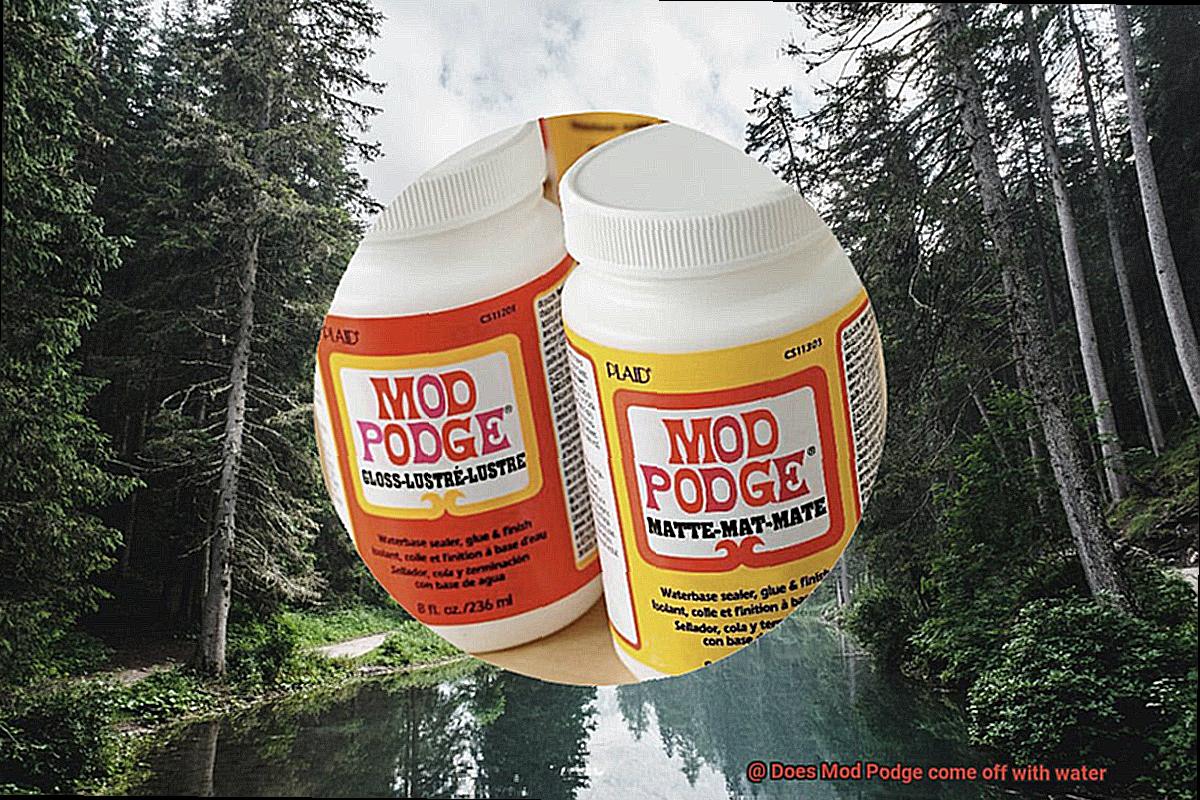
Mod Podge is a water-based adhesive with a water-resistant formula, making it suitable for projects that may occasionally encounter moisture. It dries clear and forms a protective barrier, providing some level of protection against water. However, it’s important to note that Mod Podge is not completely waterproof.
Extended exposure to water can cause Mod Podge to soften or dissolve, making it less than ideal for wet environments. Nevertheless, if you choose to use Mod Podge in such conditions, there are precautions you can take to enhance its durability.
One option is applying multiple layers of Mod Podge, allowing each layer to dry completely before adding the next. This method creates a stronger seal and provides extra protection against moisture.
Another precautionary measure is using a waterproof sealant or varnish over the Mod Podge. This additional layer adds an extra level of defense against water and enhances the overall water resistance of your project.
It’s worth noting that there are different formulas of Mod Podge available, including Outdoor Mod Podge. Specifically designed for outdoor projects, this formula offers increased resistance to water and other weather conditions. If you’re working on something intended for your garden or patio, Outdoor Mod Podge might be the better choice.
Ultimately, whether or not it is recommended to use Mod Podge in wet environments depends on the specific project and the level of water exposure involved. For crafts or items that will only have occasional contact with water, using Mod Podge should be suitable with proper precautions in place. However, for items that will constantly face water or heavy moisture, it may be wise to explore alternative adhesive options specifically designed for these conditions.
As with any crafting project, it’s always advisable to test Mod Podge in a small, inconspicuous area before using it in a wet environment. This test will help assess its water resistance capabilities and determine if it is suitable for your specific project.
What is the Best Way to Remove Mod Podge from a Surface?
Fear not, my fellow crafters. In this comprehensive guide, I will unveil the best techniques and materials to successfully remove Mod Podge from any surface. So grab your cleaning supplies and let’s embark on this glue-removal adventure.
Warm Soapy Water:
For surfaces that can handle a little moisture, such as glass or metal, start by concocting a mixture of warm water and mild dish soap. Apply this magical elixir to the Mod Podge and let it work its wonders for a few minutes. As the adhesive softens, gently scrub the area with a soft cloth or sponge. Rinse with clean water, and voila. Your surface will be restored to its former glory.
Vinegar Solution:
Sometimes, Mod Podge clings on stubbornly, especially on hard surfaces. In these cases, turn to the trusty vinegar solution. Combine equal parts vinegar and warm water, then soak a cloth or sponge in this potent potion. Lay the soaked cloth over the Mod Podge for approximately 15 minutes, allowing it to penetrate and soften the glue. Give it a gentle scrub with the cloth or sponge, rinse with water, and watch as your surface becomes glue-free once again.
Rubbing Alcohol:
Plastic or vinyl surfaces require finesse when removing Mod Podge. Dampen a cloth with rubbing alcohol and gently rub the adhesive until it starts to dissolve. For stubborn bits that refuse to budge, enlist the aid of a soft toothbrush. Once all traces of Mod Podge have vanished, rinse with water and ensure the surface is completely dry.
Heat Gun or Hairdryer:
Wood or ceramic surfaces require a touch of heat to loosen Mod Podge’s grip. Retrieve your trusty heat gun or hairdryer and hold it approximately 6 inches away from the Mod Podge. With a circular motion, apply heat until the adhesive becomes pliable. Then, armed with a plastic scraper or credit card, scrape off the softened Mod Podge. Finish by wiping the surface clean with a damp cloth and ensuring it is thoroughly dry.
Commercial Paint Remover:
If all else fails, it’s time to bring out the big guns – a commercial paint remover. Follow the product’s instructions diligently, applying it to the Mod Podge as directed. Employ a scraper or brush to remove the softened glue, rinse, and dry the surface according to the manufacturer’s recommendations.
What Are the Potential Issues of Not Removing Mod Podge Properly?
Don’t worry, we’ve all been there. Whether you’re a seasoned pro or just starting out, it’s crucial to know how to properly remove Mod Podge from your projects. Trust me, you’ll thank me later.
So, what are the potential issues of not removing Mod Podge properly? Let’s dive in and find out:
- Sticky Residue Nightmare: Picture this – you’ve spent hours creating a beautiful masterpiece, only to be left with a sticky residue that attracts dust and dirt like a magnet. Yikes. By not removing Mod Podge completely, you’re left with an unsightly mess that can ruin the overall appearance of your project.
- Project Deterioration Drama: Remember that sticky residue we mentioned earlier? Well, it doesn’t just look bad, it can also cause long-term damage to your project. Over time, the residue can break down and weaken the materials, leading to discoloration, brittleness, and even separation. Say goodbye to your hard work if you don’t remove Mod Podge properly.
- Texture Troubles: If you’re all about that smooth finish, improper removal of Mod Podge can leave you with a rough and uneven surface. Imagine running your hand over your carefully crafted table or wearable item only to feel bumps and lumps – not exactly what you had in mind, right?
- Re-Work Woes: Planning on making changes or additions to your project down the line? Well, if you didn’t remove Mod Podge properly in the first place, you’re in for a challenge. Old layers of Mod Podge can interfere with achieving a seamless result, requiring extra time and effort to remove them before proceeding with modifications.
- Durability Dilemma: Mod Podge is known for its protective sealant properties, but if you don’t remove it properly, certain areas of your project may be left vulnerable. This means your hard work could be easily damaged by environmental factors like moisture, heat, or sunlight. Talk about a crafting catastrophe.
So, how can you avoid these potential issues? Fear not, my crafty comrades. We’ve got you covered with a range of effective removal techniques. From warm soapy water to vinegar solutions, rubbing alcohol finesse, the power of heat, and even commercial paint removers – we’ve compiled a comprehensive guide just for you.
Remember, taking the time to remove Mod Podge properly will ensure the integrity and longevity of your crafting projects. Say goodbye to sticky nightmares and hello to crafting success.
DBDgmKr79DA” >
Conclusion
Mod Podge is a popular crafting glue that many people use to seal and protect their projects.
But what happens if you accidentally get it wet? Can it be easily removed with just water?
Well, the answer is not as straightforward as you might think. While Mod Podge is water-based and can be thinned or cleaned up with water when it’s still wet, once it dries, it forms a durable and permanent bond.
In fact, trying to remove dried Mod Podge with water alone can often result in smudging or damaging your project.

